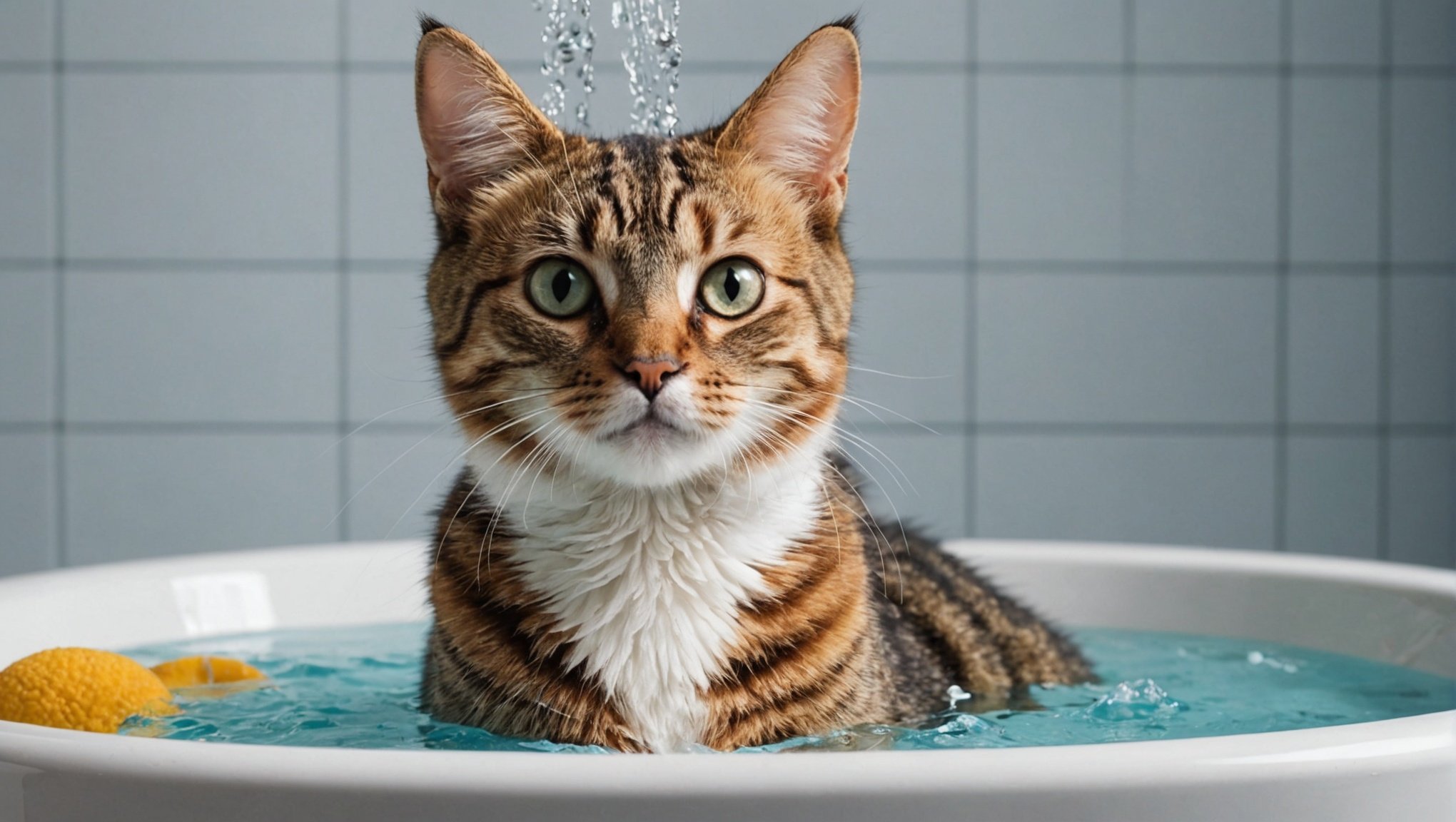Mastering the Art of Bathing: Effective Techniques for Water-Resistant Cats
When it comes to bathing, many cat owners face a daunting task, especially if their feline friends are not fond of water. However, understanding the needs and behaviors of your cat can make this process much more manageable and even beneficial for their health. Here’s a comprehensive guide on how to master the art of bathing your water-resistant cat.
Understanding Your Cat’s Aversion to Water
Before diving into the techniques, it’s essential to understand why many cats dislike water. Unlike dogs, cats are generally not natural swimmers and have a different coat structure that makes water more uncomfortable for them.
Additional reading : Ultimate Guide: Effectively Introducing Your Rescue Parrot to Other Birds
Historical Context
Historically, cats have not needed to adapt to water in the same way dogs have. For example, while dogs have been bred for various tasks including swimming, cats have primarily been hunters on land. This natural inclination away from water is deeply ingrained in their behavior and physiology[3].
Physical Comfort
Cats have a unique coat that is designed for self-grooming and insulation, not for getting wet. When their fur gets wet, it can become heavy and cold, making them uncomfortable. Additionally, the sensation of water on their skin can be unpleasant, especially if they are not accustomed to it.
Also read : Effective Strategies for Treating and Preventing Chronic Ear Infections in Dogs
Preparing Your Cat for a Bath
Preparing your cat for a bath involves several steps that can help reduce stress and make the experience more tolerable.
Choose the Right Time
- Avoid Bathing a Stressed or Hungry Cat: Make sure your cat is well-fed and calm before attempting a bath. A stressed or hungry cat will be more resistant to the bathing process.
- Select a Quiet Environment: Choose a quiet, distraction-free area where your cat feels safe and secure.
- Use Positive Reinforcement: Reward your cat with treats and praise to associate the bathing process with positive experiences.
Gather Necessary Supplies
- Mild Shampoo: Use a shampoo specifically designed for cats, as human shampoo can be too harsh for their skin.
- Warm Water: Ensure the water is not too hot or cold. Warm water is usually the most comfortable for cats.
- Non-Slip Surface: Use a non-slip mat or surface to prevent your cat from slipping and falling.
- Towels and Drying Area: Have towels ready to dry your cat immediately after the bath.
Step-by-Step Bathing Guide
Here is a detailed step-by-step guide to help you bathe your water-resistant cat.
Before the Bath
- Brush Their Coat: Brushing your cat’s coat before the bath can help remove tangles and mats, making the bathing process easier.
- Trim Nails: Trim your cat’s nails to prevent scratching during the bath.
During the Bath
- Keep it Short: Keep the bath as short as possible to minimize stress.
- Wet and Lather: Gently wet your cat with warm water, then apply the shampoo. Be careful not to get water in their ears, eyes, or nose.
- Rinse Thoroughly: Rinse your cat thoroughly to remove all soap residue.
- Dry Immediately: Dry your cat immediately with a towel to prevent them from getting cold.
After the Bath
- Provide a Warm Space: Provide a warm, quiet space for your cat to relax and dry completely.
- Monitor Their Health: Keep an eye on your cat’s health after the bath. If they show signs of stress or discomfort, consult with your veterinarian.
Tips for Making the Experience More Comfortable
Here are some additional tips to make the bathing experience more comfortable for your cat:
Use Calming Aids
- Essential Oils: Certain essential oils, like lavender, can have a calming effect on cats. However, always consult with a veterinarian before using any new products.
- Pheromone Products: Products containing synthetic pheromones can help calm your cat during the bathing process.
Create a Positive Environment
- Play Calming Music: Playing calming music can help create a soothing atmosphere.
- Keep the Room Warm: Ensure the room is warm and cozy to make your cat feel more comfortable.
Health Benefits of Bathing Your Cat
While many cats may not like water, bathing can have several health benefits when done correctly.
Skin Health
- Remove Dirt and Allergens: Bathing can help remove dirt, allergens, and parasites from your cat’s skin, improving their overall skin health.
- Reduce Shedding: Regular bathing can help reduce shedding, especially for cats with long hair.
Mental Health
- Reduce Stress: While the bathing process itself can be stressful, a clean and well-groomed cat can feel more relaxed and comfortable in the long term.
- Improve Social Interaction: A well-groomed cat may be more inclined to interact socially, both with humans and other pets.
Comparing Bathing Techniques: A Table
Here is a comparative table of different bathing techniques and their suitability for water-resistant cats:
| Technique | Description | Suitability for Water-Resistant Cats |
|---|---|---|
| Full Immersion Bath | The cat is fully submerged in water. | Not recommended; can be very stressful. |
| Partial Bath | Only specific areas of the cat are bathed. | Recommended; reduces stress and focuses on dirty areas. |
| Spot Cleaning | Using a damp cloth to clean specific spots. | Highly recommended; minimizes water exposure. |
| Dry Shampoo | Using a dry shampoo powder or spray. | Recommended; no water is involved. |
Practical Insights and Actionable Advice
Here are some practical insights and actionable advice to help you in your journey to master the art of bathing your water-resistant cat:
Choosing the Right Products
- Mild Shampoos: Always use shampoos specifically designed for cats to avoid skin irritation.
- Non-Slip Mats: Use non-slip mats in the bathtub or shower to prevent your cat from slipping.
Creating a Routine
- Regular Grooming: Regular grooming can help reduce the need for baths and make your cat more comfortable with the process.
- Gradual Exposure: Gradually expose your cat to water and bathing processes to help them become more accustomed.
Consulting Professionals
- Veterinarian Advice: Always consult with your veterinarian for specific advice on bathing your cat, especially if they have health issues.
- Professional Groomers: If you are unsure or uncomfortable bathing your cat, consider taking them to a professional groomer.
Real-Life Examples and Anecdotes
Here are a few real-life examples and anecdotes that illustrate the importance of patience and preparation when bathing a water-resistant cat:
A Personal Experience
“I once had a cat named Jase who hated water. One day, I needed to bathe him due to a skin condition. I prepared everything in advance, including a non-slip mat, mild shampoo, and warm water. I also made sure to keep the bath short and rewarding. To my surprise, Jase was much calmer than I expected, and the bath actually seemed to relieve his discomfort. It was a valuable lesson in the importance of preparation and patience when dealing with water-resistant cats.”
A Professional’s Insight
“From my years of experience as a veterinarian, I’ve seen many cats that are resistant to water. However, with the right approach, even the most water-averse cat can be bathed safely and effectively. It’s all about understanding their specific needs and creating a comfortable environment. For instance, using calming aids like pheromone products and ensuring the room is warm can make a significant difference,” says Dr. Jane Smith, a veterinarian with over 10 years of experience.
Bathing a water-resistant cat is not an impossible task, but it does require careful planning, patience, and the right techniques. By understanding your cat’s aversion to water, preparing them properly, and using the right products and methods, you can make the bathing experience more comfortable and beneficial for their health. Remember, every cat is different, so it’s crucial to tailor your approach to their specific needs and personality.
Final Tips
- Be Patient: Bathing a cat takes time and patience. Don’t rush the process.
- Make it Positive: Use positive reinforcement to make the experience more enjoyable for your cat.
- Seek Professional Help: If you’re unsure or uncomfortable, don’t hesitate to seek help from a professional groomer or veterinarian.
By following these guidelines and tips, you can master the art of bathing your water-resistant cat and ensure their long-term health and well-being.










